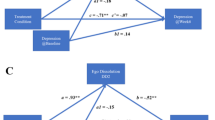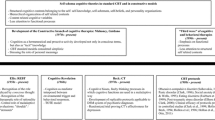Abstract
Cognitive dysfunction is central to our understanding of mood disorders in terms of patient experiences, Diagnostic and Statistical Manual of Mental Disorders criteria, and psychological models. In this article, we highlight key findings from studies that have used neuropsychological tests and functional neuroimaging techniques to explore cognitive dysfunction in patients with depression and mania. In particular, we focus on affective processing bias, abnormal response to negative feedback, and decision making. Results are discussed in the context of current conceptualizations of dysfunctional neural circuitry, and in relation to important clinical and research implications.
Similar content being viewed by others
References and Recommended Reading
World Health Organization: The Global Burden of Disease Report. Available at: www.who.int/ewvidence/bod. Accessed September 29, 2006.
World Health Organization: Mental Health: New Understanding, New Hope. Geneva: World Health Organization; 2001.
Wyatt RJ, Henter I: An economic evaluation of manicdepressive illness—1991. Soc Psychiatry Psychiatr Epidemiol 1995, 30:213–219.
Das Gupta R, Guest JF: Annual cost of bipolar disorder to UK society. Br J Psychiatry 2002, 180:227–233.
Seligman ME: Learned helplessness. Annu Rev Med 1972, 23:407–412.
Seligman ME, Abramson LY, Semmel A, von Baeyer C: Depressive attributional style. J Abnorm Psychol 1979, 88:242–247.
Beck AT, Rush AJ, Shaw BF, Emery G: Cognitive Therapy of Depression. New York: Guilford Press; 1979.
Beck AT: The past and future of cognitive therapy. J Psychother Pract Res 1997, 6:276–284.
Chamberlain SR, Blackwell AD, Fineberg N, et al.: The neuropsychology of obsessive compulsive disorder: the importance of failures in cognitive and behavioural inhibition as candidate endophenotypic markers. Neurosci Biobehav Rev 2005, 29:399–419. This is a discussion of overlapping neural circuitry between obsessivecompulsive disorder and depression, and the need to carefully dissociate distinct and overlapping features of different conditions.
Gottesman II, Gould TD: The endophenotype concept in psychiatry: etymology and strategic intentions. Am J Psychiatry 2003, 160:636–645. This article discusses the importance of the endophenotype (intermediate disease marker) concept in psychiatry.
Drevets WC: Functional anatomical abnormalities in limbic and prefrontal cortical structures in major depression. Prog Brain Res 2000, 126:413–431.
Seminowicz DA, Mayberg HS, McIntosh AR, et al.: Limbicfrontal circuitry in major depression: a path modeling metanalysis. Neuroimage 2004, 22:409–418.
Chamberlain SR, Sahakian B: Neuropsychological assessment of mood disorder. Clin Neuropsychiatry J Treat Eval 2005, 2:137–148. This is a more detailed discussion of practical issues in neuropsychologic assessment, and the search for state and trait markers of mood disorder.
Blumberg HP, Charney DS, Krystal JH: Frontotemporal neural systems in bipolar disorder. Semin Clin Neuropsychiatry 2002, 7:243–254.
Blumberg HP, Stern E, Martinez D, et al.: Increased anterior cingulate and caudate activity in bipolar mania. Biol Psychiatry 2000, 48:1045–1052.
Alexander GE, DeLong MR, Strick PL: Parallel organization of functionally segregated circuits linking basal ganglia and cortex. Annu Rev Neurosci 1986, 9:357–381.
Lawrence AD, Sahakian BJ, Robbins TW: Cognitive functions and corticostriatal circuits: insights from Huntington’s disease. Trend Cogn Sci 1998, 2:379–388.
Mayberg HS: Positron emission tomography imaging in depression: a neural systems perspective. Neuroimaging Clin N Am 2003, 13:805–815.
Mayberg HS, Brannan SK, Mahurin RK, et al.: Cingulate function in depression: a potential predictor of treatment response. Neuroreport 1997, 8:1057–1061.
Goldapple K, Segal Z, Garson C: Modulation of cortical-limbic pathways in major depression: treatment-specific effects of cognitive behavior therapy. Arch Gen Psychiatry 2004, 61:34–41.
Clark L, Cools R, Robbins TW: The neuropsychology of ventral prefrontal cortex: decision-making and reversal learning. Brain Cogn 2004, 55:41–53.
Kumar A, Gupta RC, Albert Thomas M, et al.: Biophysical changes in normal-appearing white matter and subcortical nuclei in late-life major depression detected using magnetization transfer. Psychiatry Res 2004, 130:131–140.
Chamberlain SR, Sahakian BJ: Cognition in mania and depression: psychological models and clinical implications. Curr Psychiatry Rep 2004, 6:451–458.
Chaouloff F: Serotonin, stress and corticoids. J Psychopharmacol 2000, 14:139–151.
O’Toole SM, Sekula LK, Rubin RT: Pituitary-adrenal cortical axis measures as predictors of sustained remission in major depression. Biol Psychiatry 1997, 42:85–89.
Varghese FP, Brown ES: The hypothalamic-pituitaryadrenal axis in major depressive disorder: a brief primer for primary care physicians. Prim Care Companion J Clin Psychiatry 2001, 3:151–155.
Brown ES, Varghese FP, McEwen BS: Association of depression with medical illness: Does cortisol play a role? Biol Psychiatry 2004, 55:1–9.
Goodyer IM, Herbert J, Tamplin A: Psychoendocrine antecedents of persistent first-episode major depression in adolescents: a community-based longitudinal enquiry. Psychol Med 2003, 33:601–610.
Krishnan KR, Doraiswamy PM, Lurie SN, et al.: Pituitary size in depression. J Clin Endocrinol Metab 1991, 72:256–259.
Nemeroff CB, Krishnan KR, Reed D, et al.: Adrenal gland enlargement in major depression. A computed tomographic study. Arch Gen Psychiatry 1992, 49:384–387.
Sassi RB, Nicoletti M, Brambilla P, et al.: Decreased pituitary volume in patients with bipolar disorder. Biol Psychiatry 2001, 50:271–280.
Sapolsky RM, Pulsinelli WA: Glucocorticoids potentiate ischemic injury to neurons: therapeutic implications. Science 1985, 229:1397–1400.
Chalmers DT, Kwak SP, Mansour A: Corticosteroids regulate brain hippocampal 5-HT1A receptor mRNA expression. J Neurosci 1993, 13:914–923.
Kuroda Y, Watanabe Y, Albeck DS, et al.: Effects of adrenalectomy and type I or type II glucocorticoid receptor activation on 5-HT1A and 5-HT2 receptor binding and 5-HT transporter mRNA expression in rat brain. Brain Res 1994, 648:157–161.
Meijer OC, de Kloet ER: Corticosterone suppresses the expression of 5-HT1A receptor mRNA in rat dentate gyrus. Eur J Pharmacol 1994, 266:255–261.
Meijer OC, de Kloet ER: A role for the mineralocorticoid receptor in a rapid and transient suppression of hippocampal 5-HT1A receptor mRNA by corticosterone. J Neuroendocrinol 1995, 7:653–657.
Meijer OC, Cole TJ, Schmid W, et al.: Regulation of hippocampal 5-HT1A receptor mRNA and binding in transgenic mice with a targeted disruption of the glucocorticoid receptor. Brain Res Mol Brain Res 1997, 46:290–296.
Stokes PE: The potential role of excessive cortisol induced by HPA hyperfunction in the pathogenesis of depression. Eur Neuropsychopharmacol 1995, 5(Suppl):77–82.
Domes G, Heinrichs M, Reichwald U, Hautzinger M: Hypothalamic-pituitary-adrenal axis reactivity to psychological stress and memory in middle-aged women: High responders exhibit enhanced declarative memory performance. Psychoneuroendocrinology 2002, 27:843–853.
Dinan T: Novel approaches to the treatment of depression by modulating the hypothalamic - pituitary - adrenal axis. Hum Psychopharmacol 2001, 16:89–93.
Reus VI, Wolkowitz OM: Antiglucocorticoid drugs in the treatment of depression. Expert Opin Investig Drugs 2001, 10:1789–1796.
Harmer CJ, Bhagwagar Z, Shelley N, Cowen PJ: Contrasting effects of citalopram and reboxetine on waking salivary cortisol. Psychopharmacology (Berl) 2003, 167:112–114.
Breslow R, Kocsis J, Belkin B: Memory deficits in depression: evidence utilizing the Wechsler Memory Scale. Percept Mot Skills 1980, 51:541–542.
Calev A, Korin Y, Shapira B, et al.: Verbal and non-verbal recall by depressed and euthymic affective patients. Psychol Med 1986, 16:789–794.
Cambridge Neuropsychological Test Automated Battery (CANTAB), Cambridge Cognition. Available at: www.camcog.com. Accessed September 29, 2006.
Tavares JV, Drevets WC, Sahakian BJ: Cognition in mania and depression. Psychol Med 2003, 33:959–967.
Kupfer DJ: Research in affective disorders comes of age. Am J Psychiatry 1999, 156:165–167.
Brittlebank AD, Scott J, Williams JM, Ferrier IN: Autobiographical memory in depression: state or trait marker? Br J Psychiatry 1993, 162:118–121.
Williams JM, Scott J: Autobiographical memory in depression. Psychol Med 1988, 18:689–695.
Lembke A, Ketter TA: Impaired recognition of facial emotion in mania. Am J Psychiatry 2002, 159:302–304.
Murphy FC, Sahakian BJ, Rubinsztein JS, et al.: Emotional bias and inhibitory control processes in mania and depression. Psychol Med 1999, 29:1307–1321.
Elliott R, Rubinsztein JS, Sahakian BJ, et al.: Selective attention to emotional stimuli in a verbal go/no-go task: an fMRI study. Neuroreport 2000, 11:1739–1744.
Drevets WC, Price JL, Simpson JR, Jr, et al.: Subgenual prefrontal cortex abnormalities in mood disorders. Nature 1997, 386:824–827.
Elliott R, Rubinsztein JS, Sahakian BJ, Dolan RJ: The neural basis of mood-congruent processing biases in depression. Arch Gen Psychiatry 2002, 59:597–604.
Elliott R, Ogilvie A, Rubinsztein JS, et al.: Abnormal ventral frontal response during performance of an affective go/no go task in patients with mania. Biol Psychiatry 2004, 55:1163–1170.
Elliott R, Baker SC, Rogers RD, et al.: Prefrontal dysfunction in depressed patients performing a complex planning task: a study using positron emission tomography. Psychol Med 1997, 27:931–942.
Elliott R, Sahakian BJ, Herrod JJ, et al.: Abnormal response to negative feedback in unipolar depression: evidence for a diagnosis specific impairment. J Neurol Neurosurg Psychiatry 1997, 63:74–82.
Steffens DC, Wagner HR, Levy RM, et al.: Performance feedback deficit in geriatric depression. Biol Psychiatry 2001, 50:358–363.
Murphy FC, Michael A, Robbins TW, Sahakian BJ: Neuropsychological impairment in patients with major depressive disorder: the effects of feedback on task performance. Psychol Med 2003, 33:455–467.
Evers EA, Cools R, Clark L, et al.: Serotonergic modulation of prefrontal cortex during negative feedback in probabilistic reversal learning. Neuropsychopharmacology 2005, 30:1138–1147.
Rogers RD, Everitt BJ, Baldacchino A, et al.: Dissociable deficits in the decision-making cognition of chronic amphetamine abusers, opiate abusers, patients with focal damage to prefrontal cortex, and tryptophan-depleted normal volunteers: evidence for monoaminergic mechanisms. Neuropsychopharmacology 1999, 20:322–339.
Bechara A, Damasio AR, Damasio H, Anderson SW: Insensitivity to future consequences following damage to human prefrontal cortex. Cognition 1994, 50:7–15.
Bechara A, Damasio H, Damasio AR, Lee GP: Different contributions of the human amygdala and ventromedial prefrontal cortex to decision-making. J Neurosci 1999, 19:5473–5481.
Bechara A, Damasio H, Tranel D, Anderson SW: Dissociation of working memory from decision making within the human prefrontal cortex. J Neurosci 1998, 18:428–437.
Rogers RD, Owen AM, Middleton HC, et al.: Choosing between small, likely rewards and large, unlikely rewards activates inferior and orbital prefrontal cortex. J Neurosci 1999, 19:9029–9038.
Murphy FC, Rubinsztein JS, Michael A, et al.: Decisionmaking cognition in mania and depression. Psychol Med 2001, 31:679–693.
Rubinsztein JS, Fletcher PC, Rogers RD, et al.: Decisionmaking in mania: a PET study. Brain 2001, 124:2550–2563.
O’Brien JT, Sahakian BJ, Checkley SA: Cognitive impairments in patients with seasonal affective disorder. Br J Psychiatry 1993, 163:338–343.
Silverstein ML, Harrow M, Bryson GJ: Neuropsychological prognosis and clinical recovery. Psychiatry Res 1994, 52:265–272.
Ferrier IN, Stanton BR, Kelly TP, Scott J: Neuropsychological function in euthymic patients with bipolar disorder. Br J Psychiatry 1999, 175:246–251.
Rubinsztein JS, Michael A, Paykel ES, Sahakian BJ: Cognitive impairment in remission in bipolar affective disorder. Psychol Med 2000, 30:1025–1036.
Coull JT, Frith CD, Frackowiak RS, Grasby PM: A frontoparietal network for rapid visual information processing: a PET study of sustained attention and working memory. Neuropsychologia 1996, 34:1085–1095.
Author information
Authors and Affiliations
Corresponding author
Rights and permissions
About this article
Cite this article
Chamberlain, S.R., Sahakian, B.J. The neuropsychology of mood disorders. Curr Psychiatry Rep 8, 458–463 (2006). https://doi.org/10.1007/s11920-006-0051-x
Issue Date:
DOI: https://doi.org/10.1007/s11920-006-0051-x




